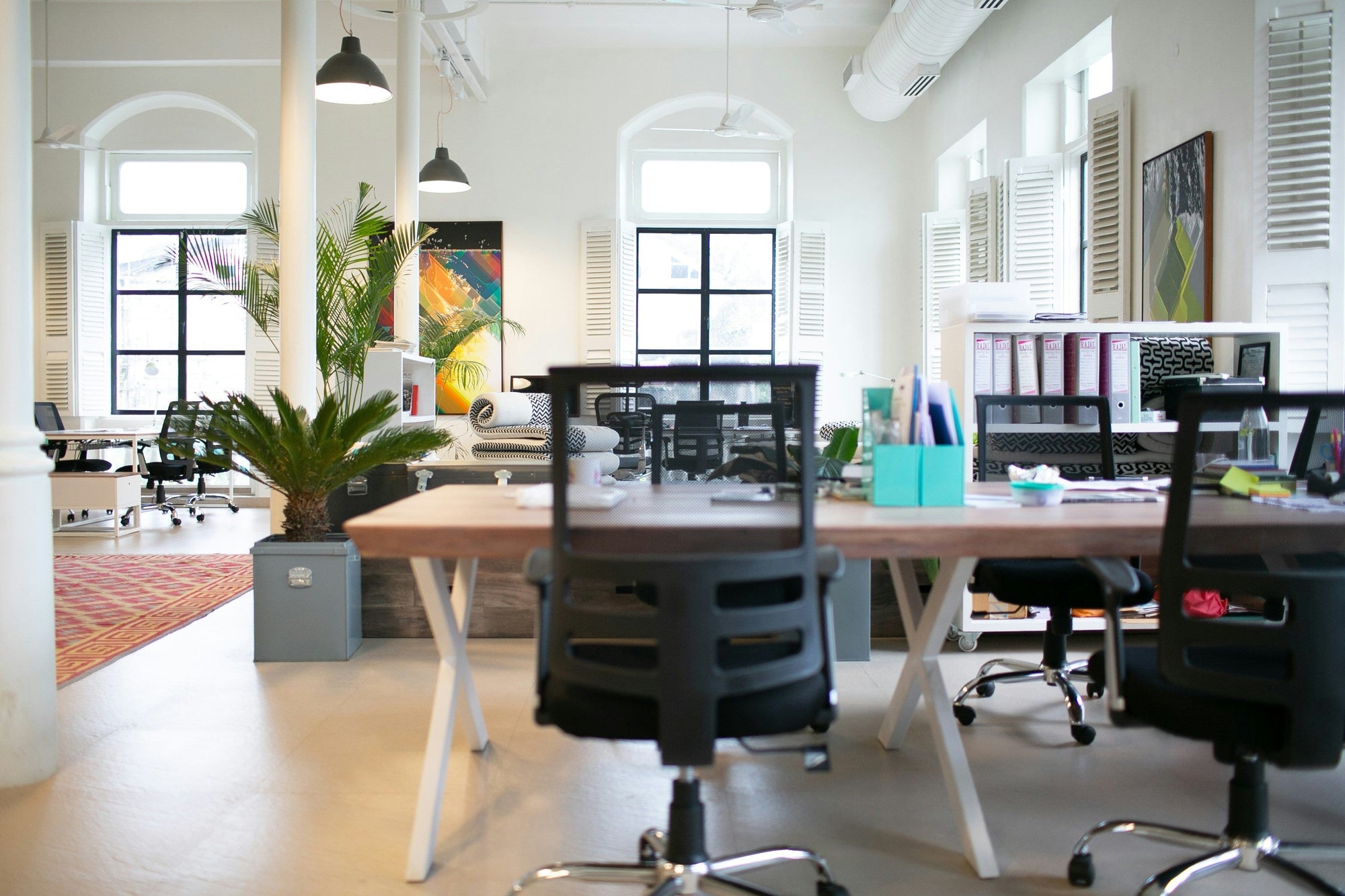The workplace is more than just a space to get things done; it’s an environment that directly impacts employee health, happiness, and productivity. As organizations increasingly recognize the importance of wellness in their overall success, workplace wellness programs have taken center stage. From mental health initiatives to physical fitness perks, businesses are investing in ways to keep employees healthy and engaged. But one critical aspect that’s often overlooked is the role of office furniture in these efforts.
At Kansas City Office Design, we specialize in crafting spaces that not only look stunning but also support employee well-being.
Explore our office design services to learn how we can transform your workspace into a wellness hub.
The furniture in your office does more than provide a place to sit or a surface to work on—it shapes the way employees move, think, and feel throughout their day. In this blog, we’ll explore how thoughtful furniture design and selection can support workplace wellness programs, boost employee well-being, and create a healthier, more productive office environment.
Why Workplace Wellness Matters
Before diving into how furniture contributes to wellness, it’s important to understand why workplace wellness is a priority for modern businesses.

-
Improved Employee Health
- Wellness programs are designed to combat common workplace issues such as stress, physical discomfort, and burnout. When employees feel better physically and mentally, they’re less likely to take sick days and more likely to perform at their best.
-
Increased Productivity
- Healthy employees are more focused, creative, and efficient. A workspace that supports their well-being can lead to higher job satisfaction and better output.
-
Enhanced Employee Retention
- Offering wellness initiatives, including ergonomic and comfortable furniture, shows employees that their employer cares about their health, leading to better retention rates and a more engaged workforce.
-
Cost Savings for Employers
- Wellness programs and supportive furniture can reduce healthcare costs by minimizing workplace injuries, chronic pain, and stress-related illnesses.
Now that we’ve established the importance of wellness in the workplace, let’s explore how furniture plays a role in achieving it.
Ergonomics: The Cornerstone of Wellness-Centric Furniture
Ergonomics refers to the science of designing furniture and tools to fit the human body, minimizing discomfort and risk of injury. Ergonomic office furniture is a fundamental component of any workplace wellness program, as it directly addresses common issues like back pain, neck strain, and repetitive stress injuries.
1. Ergonomic Chairs
-
Features to Look For:
- Adjustable seat height and depth.
- Lumbar support to maintain the natural curve of the spine.
- Armrests that can be raised, lowered, or angled.
- Swivel and tilt capabilities for better movement.
-
How They Support Wellness:
Ergonomic chairs reduce pressure on the lower back and improve posture, which can prevent chronic pain and improve focus.

2. Sit-Stand Desks
-
Features to Look For:
- Adjustable height to switch between sitting and standing.
- Programmable settings for frequently used heights.
-
How They Support Wellness:
Sit-stand desks encourage movement throughout the day, reducing the risks associated with prolonged sitting, such as poor circulation and fatigue.
3. Ergonomic Accessories
-
Examples:
- Monitor arms to adjust screen height and angle.
- Footrests to reduce leg strain.
- Wrist rests for keyboard and mouse use.
-
How They Support Wellness:
These accessories minimize strain on the eyes, neck, and wrists, promoting a more comfortable work experience.

Promoting Movement Through Furniture Design
One of the biggest challenges in office environments is sedentary behavior. Long hours of sitting can lead to a host of health problems, including obesity, heart disease, and musculoskeletal disorders. Furniture that promotes movement is a key solution.

1. Active Seating
- Active seating options, such as stability balls, wobble stools, and kneeling chairs, encourage subtle movement and engage core muscles.
- Benefits: Improved posture, better balance, and reduced risk of back pain.
2. Collaborative Furniture
- Modular furniture and standing meeting tables make it easy for employees to switch between sitting, standing, and moving during collaborative sessions.
- Benefits: Fosters creativity and teamwork while preventing stagnation.
3. Flexible Workstations
- Furniture that allows employees to reconfigure their workstations—such as adjustable desks or movable partitions—supports dynamic workflows and keeps employees physically engaged.
Mental Wellness and the Role of Design
Mental health is just as important as physical health, and furniture plays a significant role in creating an environment that supports a healthy mind.
1. Calming Colors and Comfortable Materials
- Colors like blue, green, and soft neutrals can reduce stress and promote focus.
- Comfortable materials like soft upholstery and natural wood finishes create a soothing atmosphere.
2. Wellness Zones
- Dedicated areas for relaxation, meditation, or quiet work can be furnished with lounge chairs, cushions, or even bean bags.
- Benefits: Helps employees recharge, reducing stress and boosting mental clarity.
3. Biophilic Design
- Incorporating natural elements like plants, wooden furniture, and natural light improves mood and reduces stress.
- Furniture Tip: Use plant stands, desks with built-in greenery, or chairs made from sustainable materials to bring nature indoors.
Furniture for Social Wellness
Workplace wellness isn’t just about individual health—it’s also about fostering a sense of community and collaboration. Furniture can facilitate social interactions that improve morale and team cohesion.
1. Collaborative Furniture
- Large conference tables, huddle pods, and modular seating arrangements encourage teamwork and communication.
2. Break Room Furniture
- Comfortable seating, communal tables, and bar stools create an inviting space for employees to relax and socialize.
3. Outdoor Furniture
- Providing outdoor seating or picnic tables gives employees a place to enjoy fresh air and connect with colleagues.
Sustainability and Wellness
Sustainability is closely tied to wellness, as eco-friendly furniture contributes to a healthier planet and workspace.
1. Non-Toxic Materials
- Furniture made with low-VOC (volatile organic compounds) materials reduces exposure to harmful chemicals.
2. Sustainable Sourcing
- Desks, chairs, and tables made from recycled or sustainably sourced materials align with corporate social responsibility goals.
3. Longevity and Durability
- High-quality furniture lasts longer, reducing waste and ensuring a safe, comfortable environment for years to come.
How Kansas City Office Design Supports Workplace Wellness
At Kansas City Office Design, we specialize in creating workspaces that prioritize both form and function. Our approach to furniture selection and design revolves around the principles of workplace wellness.

1. Tailored Solutions
- We work closely with clients to understand their unique needs and goals, selecting furniture that enhances well-being and productivity.
2. Expert Guidance
- Our team stays up-to-date on the latest trends in ergonomic and wellness-focused furniture, ensuring clients have access to cutting-edge solutions.
3. Seamless Integration
- From planning to installation, we ensure that every piece of furniture fits seamlessly into the overall design, maximizing its impact.
Contact us today to discuss how we can support your wellness program.
Real-Life Examples of Wellness-Centric Furniture
Case Study: A Tech Startup
- Challenge: Employees were experiencing back pain and fatigue due to prolonged sitting.
- Solution: We introduced ergonomic chairs, sit-stand desks, and active seating options. The result was a noticeable increase in comfort and productivity.
Case Study: A Marketing Agency
- Challenge: Stress levels were high due to tight deadlines and a fast-paced environment.
- Solution: We created wellness zones with lounge chairs, calming colors, and biophilic elements. Employees reported feeling more relaxed and focused.
Conclusion
Healthy minds and healthy bodies are the foundation of a thriving workplace. By integrating wellness-centric furniture into office design, businesses can create environments that support both physical and mental well-being. From ergonomic chairs to collaborative spaces, the right furniture choices can transform the workplace into a hub of health, happiness, and productivity.
At Kansas City Office Design, we’re passionate about helping businesses achieve their wellness goals through thoughtful design and furniture solutions. Ready to elevate your office? Contact us today, and let’s create a space where healthy minds and bodies thrive.







